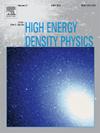f(R,T2)重力下无奇点宇宙的动力学
IF 0.9
3区 物理与天体物理
Q3 PHYSICS, FLUIDS & PLASMAS
引用次数: 0
摘要
本文研究了f(R,T2)理论背景下的弹跳宇宙学解,其中R表示Ricci标量,T2 = tξ η表示应力能量张量的自缩。为此,我们分析了具有完美物质分布的平坦弗里德曼-罗伯逊-沃克时空,并假设了f(R,T2)理论的特定函数形式,以探讨修正引力对宇宙动力学的影响。进一步,我们评估了超级弹跳和指数弹跳模型来研究这个框架下的非奇异宇宙。能量密度的正行为和压力的负行为以及零能量条件保证了宇宙弹跳解的存在。状态参数方程表示超级弹跳模型对应的幻区和指数弹跳模型对应的精粹时代,表明宇宙经历了宇宙加速度。通过线性扰动分析了得到的解的稳定性,证明了模型对小波动的鲁棒性,并证实了其作为理解宇宙演化框架的有效性。我们的发现表明,这种修正的引力理论为标准宇宙学提供了另一种框架,为引力相互作用和早期宇宙演化提供了见解。本文章由计算机程序翻译,如有差异,请以英文原文为准。
Dynamics of a singularity-free universe in f(R,T2) Gravity
This study investigates bouncing cosmological solutions to understand cosmic evolution in the background of theory, where denotes the Ricci scalar and is the self-contraction of the stress energy tensor. For this purpose, we analyze a flat Friedmann–Robertson–Walker spacetime with perfect matter distribution and assume a specific functional form of theory to explore the effects of modified gravity on cosmic dynamics. Further, we evaluate super bounce and exponential bounce models to investigate the non-singular universe in this framework. The positive behavior of energy density and the negative behavior of pressure, as well as null energy condition ensure the existence of a viable cosmological bounce solutions. The equation of state parameter indicates the phantom region corresponding to the super bounce model and the quintessence era for exponential bounce model, indicating that the universe experiences cosmic acceleration. The stability of the obtained solutions is analyzed through linear perturbation, demonstrating the model’s robustness against small fluctuations and confirming its validity as a framework for understanding cosmic evolution. Our findings suggest that this modified gravitational theory provides an alternative framework to standard cosmology, offering insights into gravitational interactions and the early cosmic evolution.
求助全文
通过发布文献求助,成功后即可免费获取论文全文。
去求助
来源期刊

High Energy Density Physics
PHYSICS, FLUIDS & PLASMAS-
CiteScore
4.20
自引率
6.20%
发文量
13
审稿时长
6-12 weeks
期刊介绍:
High Energy Density Physics is an international journal covering original experimental and related theoretical work studying the physics of matter and radiation under extreme conditions. ''High energy density'' is understood to be an energy density exceeding about 1011 J/m3. The editors and the publisher are committed to provide this fast-growing community with a dedicated high quality channel to distribute their original findings.
Papers suitable for publication in this journal cover topics in both the warm and hot dense matter regimes, such as laboratory studies relevant to non-LTE kinetics at extreme conditions, planetary interiors, astrophysical phenomena, inertial fusion and includes studies of, for example, material properties and both stable and unstable hydrodynamics. Developments in associated theoretical areas, for example the modelling of strongly coupled, partially degenerate and relativistic plasmas, are also covered.
 求助内容:
求助内容: 应助结果提醒方式:
应助结果提醒方式:


